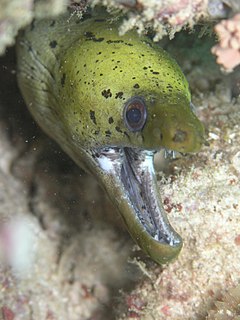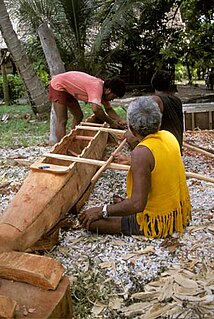Related Research Articles

Tuvalu is an island country in the Polynesian subregion of Oceania in the Pacific Ocean. Its islands are situated about midway between Hawaii and Australia. They lie east-northeast of the Santa Cruz Islands, northeast of Vanuatu, southeast of Nauru, south of Kiribati, west of Tokelau, northwest of Samoa and Wallis and Futuna, and north of Fiji. Tuvalu is composed of three reef islands and six atolls. They are spread out between the latitude of 5° and 10° south and between the longitude of 176° and 180°. They lie west of the International Date Line. Tuvalu has a population of 10,507. The total land area of the islands of Tuvalu is 26 square kilometres (10 sq mi).

The Western Pacific nation of Tuvalu, formerly known as the Ellice Islands, is situated 4,000 kilometers (2,500 mi) northeast of Australia and is approximately halfway between Hawaii and Australia. It lies east-northeast of the Santa Cruz Islands, southeast of Nauru, south of Kiribati, west of Tokelau, northwest of Samoa and Wallis and Futuna and north of Fiji. It is a very small island country of 26 km2 (10 sq mi). Due to the spread out islands it has the 38th largest Exclusive Economic Zone of 749,790 km2 (289,500 sq mi).

The first inhabitants of Tuvalu were Polynesians, so the origins of the people of Tuvalu can be traced to the spread of humans out of Southeast Asia, from Taiwan, via Melanesia and across the Pacific islands of Polynesia.

Vaitupu is the largest atoll of the nation of Tuvalu. It is located at 7.48 degrees south and 178.83 degrees east. There are 1,061 people living on 5.6 square kilometres with the main village being Asau.

The Gilbert and Ellice Islands in the Pacific Ocean were part of the British Empire from 1892 to 1976. They were a protectorate from 1892 to 12 January 1916, and then a colony until 1 January 1976. The history of the colony was mainly characterized by phosphate mining on Ocean Island. In October 1975, these islands were divided by force of law into two separate colonies, and they became independent nations shortly thereafter: the Ellice Islands became Tuvalu in 1978, and the Gilbert Islands became part of Kiribati in 1979.
Sir Toaripi Lauti was a Tuvaluan politician who served as chief minister of the Colony of Tuvalu (1975–78), as the first prime minister following Tuvalu's independence (1978–1981) and governor-general of Tuvalu (1990–1993). He was married to Sualua Tui.

Scouting in Tuvalu was first introduced in 1914, while known as the Gilbert and Ellice Islands. Scouting operated as branch of the Scout Association (UK) in the early years. The Gilbert and Ellice Scout Association was founded in 1927, and joined the World Organization of the Scout Movement in 1933. The Gilbert and Ellice Islands were separated administratively in the 1970s to become the independent Commonwealth nations of Tuvalu and Kiribati, and their Scouting movements took different paths.

Kioa is an island in Fiji, an outlier to Vanua Levu, one of Fiji's two main islands. Situated opposite Buca Bay, Kioa was purchased by settlers from Vaitupu atoll in Tuvalu, who came between 1947 and 1962.
The Congregational Christian Church of Tuvalu, commonly the Church of Tuvalu, is a Christian Church which is the state church of Tuvalu, although this status merely entitles it to "the privilege of performing special services on major national events". Its adherents comprise about 97% of the ~11,000 inhabitants of the archipelago, and theologically, it is part of the Calvinist tradition.

The following outline is provided as an overview of and topical guide to Tuvalu:

Funafuti is an atoll and the capital of the island nation of Tuvalu. It has a population of 6,320 people, and so it has more people than the rest of Tuvalu combined, with approximately 60% of the population. It consists of a narrow sweep of land between 20 and 400 metres wide, encircling a large lagoon 18 km long and 14 km wide. The average depth of the Funafuti lagoon is about 20 fathoms. With a surface area of 275 square kilometres (106.2 sq mi), it is by far the largest lagoon in Tuvalu. The land area of the 33 islets around the atoll of Funafuti totals 2.4 square kilometres (0.9 sq mi); taken together, they constitute less than one per cent of the total area of the atoll. Cargo ships can enter Funafuti's lagoon and dock at the port facilities on Fongafale.

This is a survey of the postage stamps and postal history of Tuvalu.
Motufoua Secondary School is a boarding school for children on Vaitupu atoll, Tuvalu. As of 2000 it is the largest high school in Tuvalu. As Tuvalu consists of nine islands, the students reside on Vaitupu during the school year and return to their home islands during the school vacations.
Princess Margaret Hospital (PMH) on Funafuti atoll in Tuvalu is the only hospital in the country, and the primary provider of medical services for all the islands of Tuvalu. The hospital is located about 1.3 kilometres north from the centre of Funafuti on Fongafale islet.

This timeline of the history of Tuvalu chronologically lists important events occurring within the present political boundaries of the Pacific island state of Tuvalu. This time line is introduced by the theories as to the origins of the Polynesian people and the migration across the Pacific Ocean to create Polynesia, which includes the islands of Tuvalu.

Tuvaluan mythology tells stories of the creation of the islands of Tuvalu and of the founding ancestors of each island. While on some of the islands there are stories of spirits creating the islands, a creation story that is found on many of the islands is that te Pusi mo te Ali created the islands of Tuvalu; te Ali is believed to be the origin of the flat atolls of Tuvalu and te Pusi is the model for the coconut palms that are important in the lives of Tuvaluans. The strength of this belief has the consequence that Moray eel are tapu and are not eaten.

Donald Gilbert Kennedy was a teacher, then an administrator in the British colonial service in the Gilbert and Ellice Islands Colony and the British Solomon Islands Protectorate. For his services as a Coastwatcher during the Pacific War, he was awarded the DSO, and the Navy Cross (U.S.). He published journal articles and books on the material culture of Vaitupu atoll, land tenure and the language of the Ellice Islands.

A paopao, is the name used by the Polynesian-speaking inhabitants of the Ellice Islands for their single-outrigger canoes, of which the largest could carry four to six adults. The large double-hulled sailing canoes had ceased to be constructed in the Ellice Islands some time before contact with Europeans.

The Governor of the Gilbert and Ellice Islands was the colonial head of the Gilbert and Ellice Islands civil service from 1892 until 1979.
Vivian Fox-Strangways was a British officer, Resident Commissioner of the partly occupied by Japan Gilbert and Ellice Islands, from 1941 to 1946.
References
- 1 2 G. M. White (1965). Kioa: an Ellice community in Fiji. Project for the Comparative Study of Cultural Change and Stability in Displaced Communities in the Pacific, 1962-63: Oregon University, Department of Anthropology.
- 1 2 3 4 5 6 7 Lifuka, Neli (1978). Logs in the current of the sea : Neli Lifuka's story of Kioa and the Vaitupu colonists. Australian National University Press/Press of the Langdon Associates. ISBN 0708103626.
- 1 2 3 4 5 6 Goldsmith, Michael (2008). "Chapter 8, Telling Lives in Tuvalu". Telling Pacific Lives: Prisms of Process. London: ANU E Press.
- 1 2 3 4 Lifuka, Neli (1978). "War Years In Funafuti" (PDF). Logs in the current of the sea : Neli Lifuka's story of Kioa and the Vaitupu colonists. Australian National University Press/Press of the Langdon Associates. ISBN 0708103626.
- ↑ Noatia P. Teo (1983). "Chapter 17, Colonial Rule". In Laracy, Hugh (ed.). Tuvalu: A History. University of the South Pacific/Government of Tuvalu. pp. 127–139.
- ↑ Michael Goldsmith, Review of Klaus-Friedrich Koch, Logs in the Current of the Sea, Journal of the Polynesian Society, 87:4 (1978), 361-62